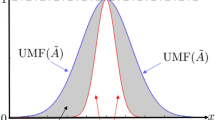Abstract
For conventional fuzzy clustering-based approaches to fuzzy system identification, a fuzzy function is used for cluster formation and another fuzzy function is used for cluster validation to determine the number and location of the clusters which define IF parts of the rule base. However, the different fuzzy functions used for cluster formation and validation may not indicate the same best number and location of the clusters. This potential disparity motivates us to propose a new fuzzy clustering-based approach to fuzzy system identification based on the bi-objective fuzzy c-means (BOFCM) cluster analysis. In this approach, we use the BOFCM function for both cluster formation and validation to simultaneously determine the number and location of the clusters which we hope can efficiently and effectively define IF parts of the rule base. The proposed approach is validated by applying it to the truck backer-upper problem with an obstacle in the center of the field.
Similar content being viewed by others
Explore related subjects
Discover the latest articles, news and stories from top researchers in related subjects.References
J. Abonyi R. Babuska F. Szeifert (2002) ArticleTitleModified Gath–Geva fuzzy clustering for identification of Takagi-Sugeno fuzzy models IEEE Transactions on Systems, Man, and Cybernetics Part B 32 612–621 Occurrence Handle10.1109/TSMCB.2002.1033180
J.C. Bezdek (1981) Pattern recognition with fuzzy objective function algorithm Plenum Press New York
J.C. Bezdek S.K. Pal (Eds) (1992) Fuzzy models for pattern recognition IEEE Press New York
J.-Q. Chen Y.-G. Xi Z.-J. Zhang (1998) ArticleTitleA clustering algorithm for fuzzy model identification Fuzzy Sets and Systems 98 319–329 Occurrence Handle1082.74518 Occurrence Handle1640915 Occurrence Handle10.1016/S0165-0114(96)00384-3
S.L. Chiu (1994) ArticleTitleFuzzy model identification based on cluster estimation Journal of Intelligent and Fuzzy Systems 2 267–278 Occurrence Handle10.1109/91.324806
O. Cordón F. Herrera M. Lozano (1997) On the combination of fuzzy logic and evolutionary computation: A short review and bibliography W. Pedrycz (Eds) Fuzzy evolutionary computation Kluwer Academic Publishers Boston
M. Delgado A. González (1993) ArticleTitleAn inductive learning procedure to identify fuzzy systems Fuzzy Sets and Systems 55 121–132 Occurrence Handle1215133 Occurrence Handle10.1016/0165-0114(93)90125-2
M. Delgado A.F. Gómez-Skarmeta F. Martín (1997) ArticleTitleA fuzzy clustering-based rapid prototyping for fuzzy rule-based modeling IEEE Transactions on Fuzzy Systems 5 223–232 Occurrence Handle10.1109/91.580797
Hall, L. O., & Lande, P. (1996). Generating fuzzy rules from data. In Proceedings of IEEE International Conference on Fuzzy Systems, Piscataway, N J, pp. 1757–1762
T.-P. Hong C.-Y. Lee (1996) ArticleTitleInduction of fuzzy rules and membership functions from training examples Fuzzy Sets and Systems 84 33–47 Occurrence Handle0906.68146 Occurrence Handle1419649 Occurrence Handle10.1016/0165-0114(95)00305-3
F. Höppner F. Klawonn R. Kruse T. Runkler (1999) Fuzzy cluster analysis: Methods for classification, data analysis and image recognition Wiley Hoboken, N J
T.-W. Hung S.-C. Fang H. Nuttle (2003) ArticleTitleA Two-phase approach to fuzzy system identification Journal of Systems Science and Systems Engineering 12 408–423 Occurrence Handle10.1007/s11518-006-0144-4
H. Ishibuchi (1996) Development of fuzzy neural networks W. Pedrycz (Eds) Fuzzy modeling paradigms and practice Kluwer Academic Publishers Boston
E. Kim M. Park S. Ji M. Park (1997) ArticleTitleA new approach to fuzzy modeling IEEE Transactions on Fuzzy Systems 5 328–337 Occurrence Handle10.1109/91.649911
D.W. Kim K.H. Lee D. Lee (2004) ArticleTitleOn cluster validity index for estimation of the optimal number of fuzzy clusters Pattern Recognition 37 2009–2025 Occurrence Handle10.1016/j.patcog.2004.04.007
Rhee, H.-S., & Oh, K.-W. (1996). A validity measure for fuzzy clustering and its use in selecting optimal number of clusters. In Proceedings of the fifth IEEE international conference on fuzzy systems, New York, N Y, pp 1020–1025.
M. Sugeno T. Yasukawa (1993) ArticleTitleA fuzzy-logic-based approach to qualitative modeling IEEE Transactions on Fuzzy Systems 1 7–31 Occurrence Handle10.1109/TFUZZ.1993.390281
Takagi, T., Sugeno, M. (1985). Fuzzy identification of systems and its application to modeling and control. IEEE Transactions on Systems, Man, and Cybernetics, SMC-15:116–132
H.-F. Wang C. Wang G.-Y. Wu (1994) ArticleTitleBi-criteria fuzzy c-means analysis Fuzzy Sets and Systems 64 311–319 Occurrence Handle0842.62053 Occurrence Handle1289537 Occurrence Handle10.1016/0165-0114(94)90154-6
L.-X. Wang J.M. Mendel (1992) ArticleTitleGenerating fuzzy rules by learning from examples IEEE Transactions on Systems, Man, and Cybernetics 22 1414–1427 Occurrence Handle1212464 Occurrence Handle10.1109/21.199466
L.-X. Wang (1997) A course in fuzzy systems and control Prentice-Hall Inc. Upper Saddle River, N J Occurrence Handle0910.93002
Xie X., Beni G. (1991). A validity measure for fuzzy clustering. IEEE Transactions on Pattern Analysis and Machine Intelligence, PAMI-13:841–847
L. A. Zadeh (1991) From circuit theory to system theory G. J. Klir (Eds) Facets of systems science Plenum Press New York
N. Zahid M. Limouri A. Essaid (1999) ArticleTitleA new cluster-validity for fuzzy clustering Pattern Recognition 32 1089–1097 Occurrence Handle10.1016/S0031-3203(98)00157-5
Author information
Authors and Affiliations
Corresponding author
Rights and permissions
About this article
Cite this article
Hung, TW. The bi-objective fuzzy c-means cluster analysis for TSK fuzzy system identification. Fuzzy Optim Decis Making 6, 51–61 (2007). https://doi.org/10.1007/s10700-006-0024-x
Issue Date:
DOI: https://doi.org/10.1007/s10700-006-0024-x




